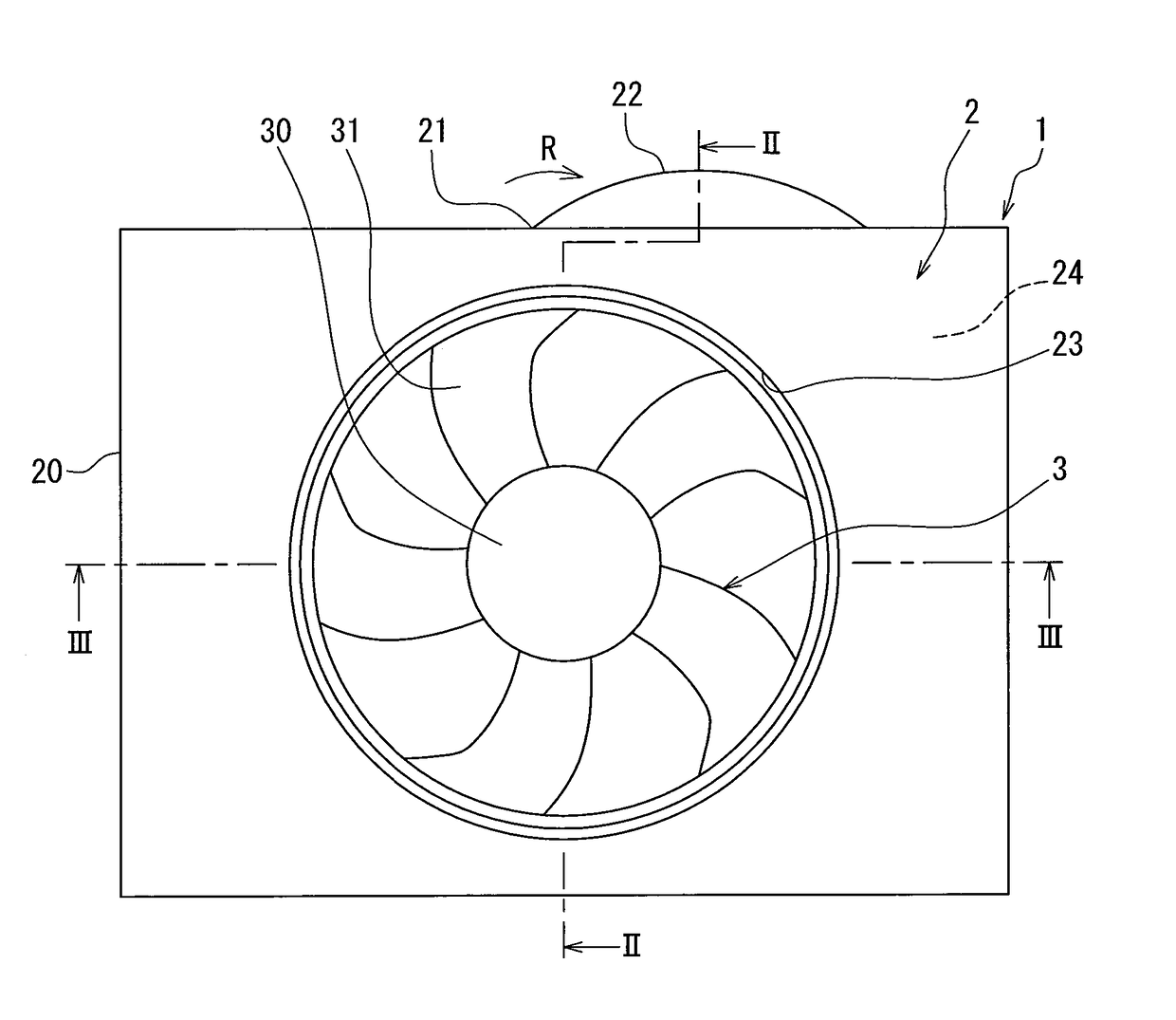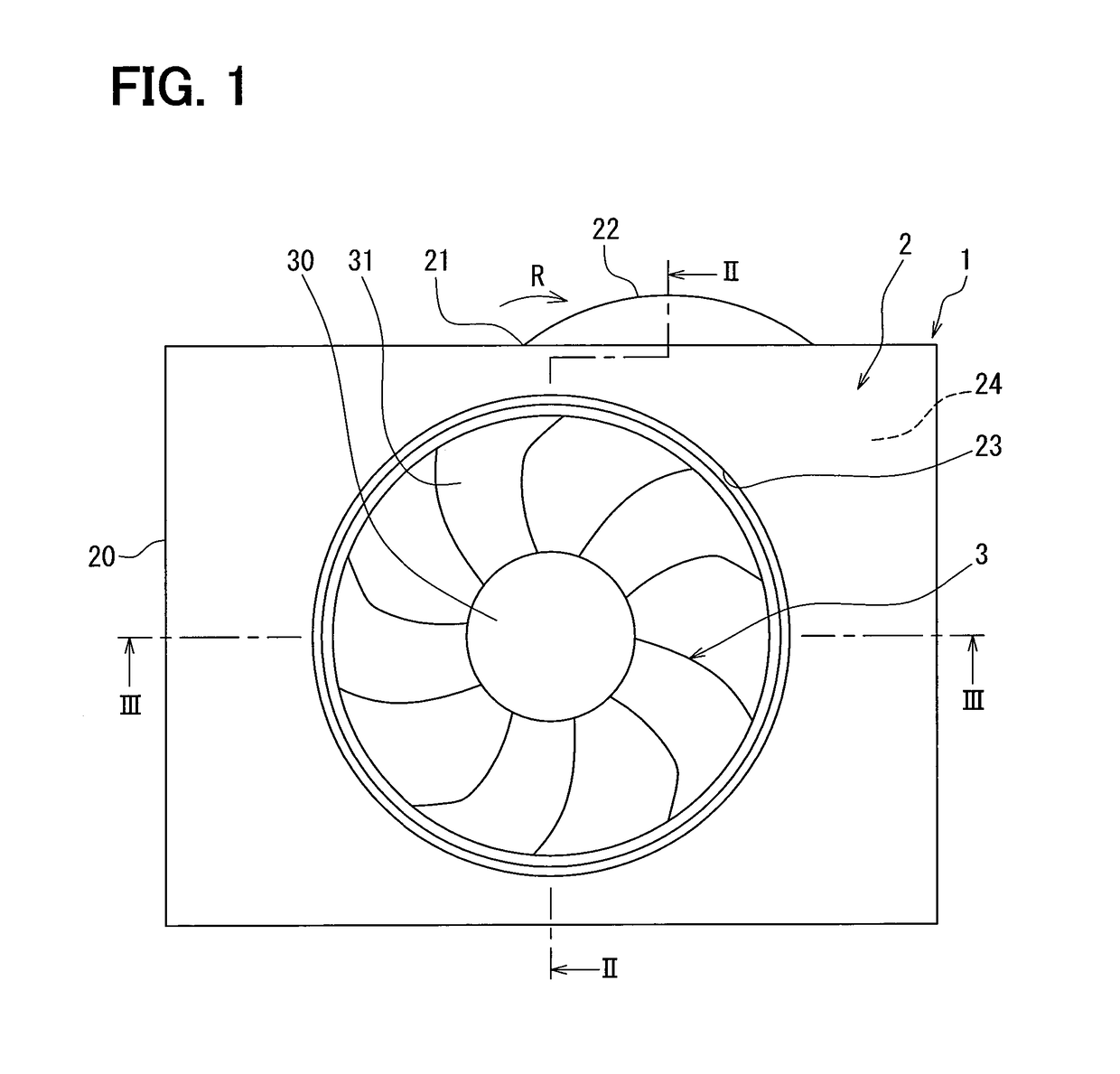Blower device
a blower and fan technology, applied in the direction of machines/engines, liquid fuel engines, transportation and packaging, etc., can solve the problems of uneven flow direction of the fan in the circumferential direction, affecting the flow rate of air blown out of the outer circumference of the fan, and affecting the flow rate of air blown out of the fan. , to achieve the effect of reducing the rotational nois
- Summary
- Abstract
- Description
- Claims
- Application Information
AI Technical Summary
Benefits of technology
Problems solved by technology
Method used
Image
Examples
first embodiment
[0029]A blower device 1 of a first embodiment of the present disclosure will be described with reference to FIGS. 1 to 4. In the first embodiment, a device will be described as an example of the blower device, and the device conveys air to a radiator that is disposed in a vehicle to cool an engine, for example. FIG. 1 is a back view illustrating the blower device 1 of the first embodiment. FIG. 2 is a sectional view showing a part of a fan shroud 2 when a sectional surface taken along a line II-II of FIG. 1 is viewed in an arrow direction. FIG. 3 is a sectional view showing a part of the fan shroud 2 when a sectional surface taken along a line III-III of FIG. 1 is viewed in an arrow direction. In FIGS. 1 to 3, a motor and a motor stay which drive a fan 3 to rotate are not shown. An arrow in the drawings shows a flow direction of air suctioned by the blower device 1.
[0030]The blower device 1 includes the fan 3 that is single and an axial flow type, and the fan shroud 2 supporting the...
second embodiment
[0047]A second embodiment is an embodiment changed in configuration of a blower device 1A from the first embodiment. FIG. 5 is a back view illustrating the blower device 1A of the second embodiment. FIG. 6 is a sectional view showing a part of a fan shroud 2A when a sectional surface taken along a line VI-VI of FIG. 5 is viewed in an arrow direction.
[0048]As shown in FIGS. 5 and 6, the blower device 1A is different from the blower device 1 of the first embodiment in that the fan shroud 2A includes a protruding end part 22A on an opposite side of an outer end portion of the fan shroud 2A from a protruding end part 22. A configuration that will not be explained is similar to that of the first embodiment, and a different configuration will be explained mainly below.
[0049]The fan shroud 2A includes the protruding end part 22A in addition to the protruding end part 22 located in an upper part. The protruding end part 22A is formed at a position advanced in a rotational direction R of a f...
third embodiment
[0051]A third embodiment is an embodiment changed in configuration of a blower device 1B from the first embodiment. FIG. 7 is a back view illustrating a blower device 1B of the third embodiment. FIG. 8 is a sectional view showing a part of a fan shroud 2B of the third embodiment.
[0052]As shown in FIGS. 7 and 8, the blower device 1B is different from the blower device 1 of the first embodiment in that shield plates 25 and 25A are provided instead of the protruding end part as a characteristic configuration for reducing rotational noise. A configuration that will not be explained is similar to that of the first embodiment, and a different configuration will be explained mainly below.
[0053]As shown in FIGS. 7 and 8, the fan shroud 2B includes the shield plate 25 and the shield plate 25A at positions where a part of flow of air blown by a fan 3 collides with the shield plates 25 and 25A. The shield plate 25 is a plate-shaped member that is located downstream of the fan 3 in a flow of su...
PUM
 Login to View More
Login to View More Abstract
Description
Claims
Application Information
 Login to View More
Login to View More - R&D
- Intellectual Property
- Life Sciences
- Materials
- Tech Scout
- Unparalleled Data Quality
- Higher Quality Content
- 60% Fewer Hallucinations
Browse by: Latest US Patents, China's latest patents, Technical Efficacy Thesaurus, Application Domain, Technology Topic, Popular Technical Reports.
© 2025 PatSnap. All rights reserved.Legal|Privacy policy|Modern Slavery Act Transparency Statement|Sitemap|About US| Contact US: help@patsnap.com



